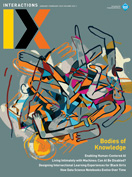Authors:
Wei Xu, Marvin Dainoff
Artificial intelligence (AI) has brought benefits, but it may also cause harm if not appropriately developed. Current development is mainly driven by a technology-centered approach, causing many failures [1,2]. For example, the AI Incident Database has documented more than a thousand AI-related accidents [3]. To address these challenges, a human-centered AI (HCAI) approach has been promoted and has received a growing level of acceptance over the past few years [1,2]. HCAI calls for combining AI with HCI design that will enable the development of AI systems (e.g., autonomous vehicles, intelligent user interfaces, or intelligent decision-making systems) to achieve its…
You must be a member of SIGCHI, a subscriber to ACM's Digital Library, or an interactions subscriber to read the full text of this article.
GET ACCESS
Join ACM SIGCHIIn addition to all of the professional benefits of being a SIGCHI member, members get full access to interactions online content and receive the print version of the magazine bimonthly.
Subscribe to the ACM Digital Library
Get access to all interactions content online and the entire archive of ACM publications dating back to 1954. (Please check with your institution to see if it already has a subscription.)
Subscribe to interactions
Get full access to interactions online content and receive the print version of the magazine bimonthly.






